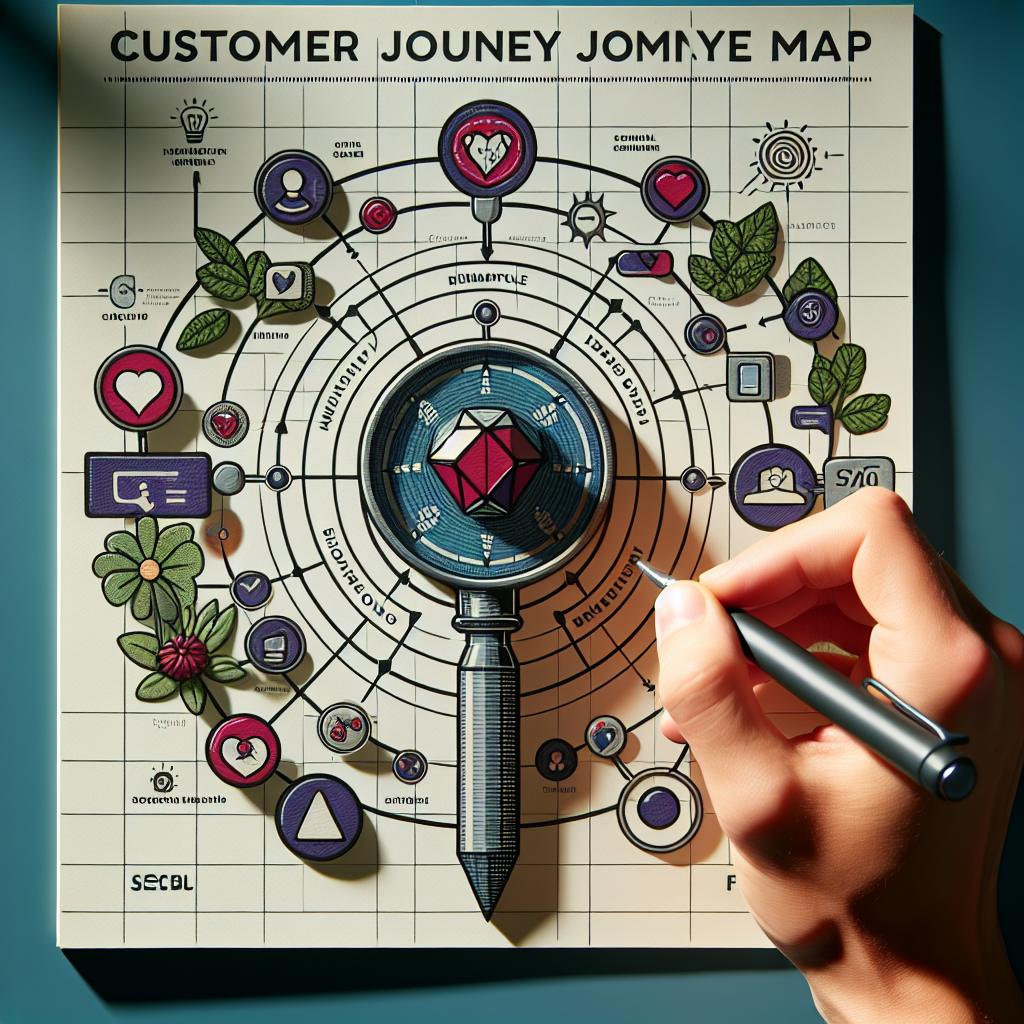Customer journey mapping for social media marketing
If you want to take your social media marketing to the next level, it’s time to dive into the world of customer journey mapping. Customer journey mapping allows you to visualize the entire experience your customers have with your brand, from the moment they discover you on social media to the point of purchase and even beyond. By understanding your customers’ needs, desires, and pain points at each stage of their journey, you can create targeted, personalized content that resonates with them. In this article, we’ll explore the key elements of customer journey mapping and how it can revolutionize your social media marketing strategy. So let’s get started and embark on this exciting journey together!
Customer Journey Mapping
Customer journey mapping is a strategic tool used by businesses to understand and analyze the entire customer experience. It involves creating a visual representation of the customer’s journey from the initial contact with the brand to the final purchase decision and beyond. This comprehensive article will delve into the definition, importance, and benefits of customer journey mapping, as well as its application in the context of social media marketing.
Definition of Customer Journey Mapping
Customer journey mapping is a process that helps businesses visualize and understand the various touchpoints and interactions that a customer has with their brand. It involves mapping out the customer’s experience at different stages, including awareness, consideration, purchase, and post-purchase. By creating a visual representation of the customer journey, businesses can gain valuable insights into customer behavior and identify areas for improvement.
Importance of Customer Journey Mapping
Customer journey mapping is essential for businesses because it enables them to gain a holistic understanding of their customers’ experience. By mapping out the customer journey, businesses can identify pain points, opportunities for improvement, and areas where they can better meet customer needs. It helps businesses align their marketing efforts and customer touchpoints with the customer’s expectations and desires, leading to increased customer satisfaction and loyalty.
Benefits of Customer Journey Mapping
-
Enhanced Customer Experience: By understanding the customer journey, businesses can identify moments that matter to the customer and enhance their overall experience. This leads to increased customer satisfaction, loyalty, and positive word-of-mouth.
-
Improved Marketing Strategies: Customer journey mapping helps businesses identify gaps in their marketing strategies and optimize their efforts accordingly. By pinpointing areas where customer engagement is low or ineffective, businesses can refine their marketing campaigns to better resonate with their target audience.
-
Increased Sales and Conversions: When businesses have a clear understanding of the customer journey, they can optimize touchpoints and interaction points to drive conversions and boost sales. By delivering the right message at the right time, businesses increase the likelihood of customers making a purchase.
-
Better Customer Service: Mapping the customer journey allows businesses to identify pain points and areas where customer service can be improved. By addressing these pain points and providing excellent customer service, businesses can foster long-term customer relationships and loyalty.
-
Competitive Advantage: By gaining a deep understanding of the customer journey, businesses can differentiate themselves from the competition. By providing a seamless and satisfying customer experience at every touchpoint, businesses can stand out and attract and retain more customers.
Understanding the Customer Journey
To effectively map the customer journey, businesses need to understand the stages of the journey, the touchpoints involved, and the emotions experienced by the customer along the way.
Stages of the Customer Journey
-
Awareness: This is the initial stage where the customer becomes aware of the brand’s existence. They may come across the brand through advertisements, social media, or word-of-mouth.
-
Consideration: At this stage, the customer evaluates the brand and compares it to other competitors. They gather information, read reviews, and seek recommendations to make an informed decision.
-
Purchase: This stage involves the actual purchase decision and transaction. The customer chooses the brand and makes the purchase.
-
Post-Purchase: After the purchase, the customer’s experience continues. This stage includes using the product or service, seeking customer support, and potentially becoming a loyal advocate for the brand.
Touchpoints in the Customer Journey
Touchpoints refer to any interaction or point of contact between the customer and the brand. These can include website visits, social media interactions, in-store experiences, customer service calls, and more. Identifying and mapping these touchpoints helps businesses understand when and where interactions occur and optimize them for maximum impact.
Mapping Customer Emotions
Understanding the customer’s emotions throughout the journey is crucial for providing a positive experience. Mapping customer emotions allows businesses to anticipate and address any negative emotions, such as frustration or confusion, and create opportunities for positive emotions, such as delight or satisfaction. By mapping emotions, businesses can tailor their messaging and customer service to meet customer expectations and needs.
Identifying Customer Pain Points
Customer pain points are areas of frustration or dissatisfaction within the customer journey. By identifying and mapping these pain points, businesses can take proactive steps to address them and improve the overall customer experience. This could involve streamlining processes, improving customer service, or enhancing product features to eliminate pain points and create a smoother journey.

Social Media Marketing and the Customer Journey
Social media plays a significant role in the customer journey, as it has become an integral part of people’s lives. Platforms like Facebook, Instagram, Twitter, and LinkedIn provide opportunities for businesses to engage with customers and influence their purchasing decisions.
Role of Social Media in the Customer Journey
Social media serves as a platform for businesses to raise awareness, build brand loyalty, and maintain ongoing relationships with customers. With millions of active users, social media platforms offer businesses the chance to reach a wide audience and interact directly with customers at different stages of the journey.
Popular Social Media Platforms for Marketing
Different social media platforms attract distinct demographics and have unique features that cater to specific marketing strategies. Facebook is the largest social media platform and offers diverse advertising options. Instagram, known for its visual appeal, provides opportunities for creative content and influencer partnerships. Twitter enables businesses to engage in real-time conversations and share updates, while LinkedIn offers a professional networking environment primarily for B2B marketing.
Key Metrics for Social Media Marketing
To measure the effectiveness of social media marketing efforts, businesses should track key metrics such as reach, engagement, follower growth, and conversion rates. These metrics provide insights into the impact of social media campaigns on the customer journey and help businesses make data-driven decisions to optimize their strategies.
How to Create a Customer Journey Map for Social Media Marketing
To create an effective customer journey map for social media marketing, businesses need to follow a systematic approach that encompasses key steps.
Define Your Customer Persona
Start by creating a detailed customer persona to understand the target audience for your social media marketing efforts. A customer persona includes demographic information, interests, behaviors, and goals. This helps businesses tailor their social media content and interactions to resonate with the target audience.
Identify Customer Touchpoints on Social Media Platforms
Once the customer persona is defined, businesses should identify the touchpoints on social media platforms where customers interact with the brand. This could include following the brand’s social media account, engaging with posts, sending direct messages, or leaving comments. By mapping these touchpoints, businesses can prioritize efforts and optimize their social media presence.
Analyze Customer Behavior and Interactions
Analyze customer behavior on social media platforms to gain insights into their preferences, interests, and interactions with your brand. This can be done through social media analytics tools that provide data on engagement, reach, clicks, and conversions. By understanding customer behavior, businesses can refine their social media strategies to align with customer needs and desires.
Track Customer Emotions and Sentiments
Monitor and track customer emotions and sentiments expressed through social media interactions. This can be done by analyzing comments, mentions, or direct messages. By understanding the emotional responses of customers, businesses can respond appropriately, address concerns, and enhance the overall customer experience on social media platforms.
Identify Gaps and Pain Points in the Customer Journey
Lastly, businesses need to identify any gaps or pain points in the customer journey related to their social media marketing efforts. This involves analyzing customer feedback, reviews, and comments to identify areas for improvement. By addressing these gaps and pain points, businesses can provide a seamless and consistent customer experience on social media platforms.

Implementing Customer Journey Mapping in Social Media Marketing
Once a customer journey map is created, businesses can implement strategies to optimize their social media marketing efforts at each stage of the journey.
Optimizing Social Media Profiles and Content
Review and optimize social media profiles to ensure alignment with the brand’s image and messaging. This includes updating profile information, using engaging visuals, and continuously posting relevant and valuable content. By optimizing social media profiles and content, businesses can make a positive first impression and capture the attention of potential customers.
Creating Relevant and Engaging Social Media Campaigns
Develop social media campaigns that align with the customer’s journey and cater to their needs and interests at each stage. This involves creating content that educates, entertains, and inspires, while reflecting the brand’s values and unique selling propositions. By developing relevant and engaging social media campaigns, businesses can capture the attention of their target audience and drive them through the purchasing journey.
Personalizing Customer Interactions on Social Media
Personalize customer interactions on social media platforms by responding to comments, messages, and mentions in a timely and personalized manner. By addressing individual customer needs, businesses can create a sense of connection and build loyalty. Personalization can also involve using customer data to tailor content and offers to specific segments of the audience.
Measuring and Monitoring Customer Engagement and Satisfaction
Continuously measure and monitor customer engagement and satisfaction on social media platforms. This can be done through social media analytics tools, tracking key performance indicators, and analyzing customer feedback. By monitoring these metrics, businesses can identify areas for improvement, measure the impact of their social media initiatives, and make data-driven decisions to optimize their strategies.
Case Studies of Customer Journey Mapping in Social Media Marketing
Real-life case studies provide valuable insights into the effective implementation of customer journey mapping in social media marketing.
Case Study 1: Successful Customer Journey Mapping on Facebook
A clothing retailer implemented customer journey mapping on Facebook and achieved significant results. By understanding their target audience’s preferences and behavior, they optimized their Facebook page, content, and advertising to cater to different stages of the customer journey. As a result, they experienced increased engagement, higher website traffic, and improved sales. This success was attributed to delivering personalized content, offering exclusive promotions, and addressing customer queries in a timely manner.
Case Study 2: Effective Customer Journey Mapping on Instagram
A beauty brand successfully implemented customer journey mapping on Instagram. By mapping the different stages of the journey, they identified touchpoints where customers interacted with their brand. They focused on visual storytelling and used user-generated content to showcase the product benefits and generate brand awareness. By engaging with followers, responding to comments, and leveraging influencer collaborations, they experienced increased follower growth, higher conversions, and improved brand loyalty.
Case Study 3: Impactful Customer Journey Mapping on Twitter
A technology company implemented customer journey mapping on Twitter to boost brand engagement and customer loyalty. They mapped the different stages of the journey and identified touchpoints where customers interacted with their brand. They actively participated in industry conversations, shared valuable insights, and leveraged Twitter polls to engage with their audience. By personalizing interactions and addressing customer pain points, they achieved higher brand visibility, increased customer satisfaction, and improved customer retention.
Challenges and Pitfalls of Customer Journey Mapping for Social Media Marketing
While customer journey mapping is a valuable tool, businesses should be aware of potential challenges and pitfalls.
Overcomplicating the Customer Journey Map
One common challenge is overcomplicating the customer journey map by including too many touchpoints or trying to map every individual customer interaction. It’s important to strike a balance between comprehensiveness and simplicity to ensure the customer journey map remains a practical and useful tool.
Relying Solely on Quantitative Data
Another challenge is relying solely on quantitative data and neglecting qualitative insights from customer feedback and interactions. While metrics like reach and engagement are important, businesses should also consider the emotional and subjective experiences of customers to gain a holistic understanding of the customer journey.
Ignoring Customer Feedback and Insights
Failing to listen to and act upon customer feedback and insights is a pitfall that can undermine the effectiveness of customer journey mapping. Businesses should actively solicit and incorporate customer feedback into their strategies, as it provides valuable insights into pain points, expectations, and areas for improvement.
Failing to Update and Adapt the Customer Journey Map
Customer journey mapping is not a one-time exercise; it should be continuously updated and adapted to reflect evolving customer expectations and market dynamics. Failing to do so can result in an outdated and ineffective customer journey map. Regularly reviewing and updating the map ensures its relevance and continues to drive meaningful insights.
Future Trends in Customer Journey Mapping for Social Media Marketing
As social media and marketing practices continue to evolve, there are several future trends in customer journey mapping to watch out for.
Integration of Artificial Intelligence and Automation
Artificial intelligence and automation technologies will play a significant role in customer journey mapping. Businesses can leverage AI-powered tools to analyze customer data, predict behavior, and automate personalized interactions. This will enhance efficiency and provide real-time insights to optimize social media marketing efforts.
Enhanced Personalization and Customization
Personalization and customization will become increasingly important in customer journey mapping. By utilizing advanced analytics and leveraging customer data, businesses can deliver targeted content, offers, and recommendations tailored to individual customer preferences. This level of personalization will enhance customer experiences and drive higher engagement and conversion rates.
Incorporation of Virtual Reality and Augmented Reality
Virtual reality (VR) and augmented reality (AR) technologies are expected to have a significant impact on the customer journey. Brands can leverage VR and AR to provide immersive experiences, allowing customers to visualize and experience products or services before making a purchase. This technology will revolutionize social media marketing by creating unique and engaging customer interactions.
In conclusion, customer journey mapping for social media marketing is a powerful tool that enables businesses to understand and optimize the customer experience. By mapping the customer journey, identifying touchpoints, tracking emotions, and addressing pain points, businesses can enhance customer satisfaction, improve marketing strategies, and ultimately drive sales and loyalty. As social media and marketing practices continue to evolve, businesses should embrace future trends like AI integration, enhanced personalization, and the incorporation of VR and AR to stay ahead of the competition and deliver exceptional customer experiences.
















It's great that you talked about how business insurance can provide financial protection against unexpected events and help ensure the…
I like that you mentioned how business insurance is essential for protecting your bottom line and the long-term viability of…